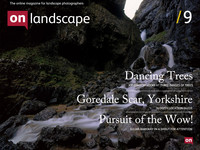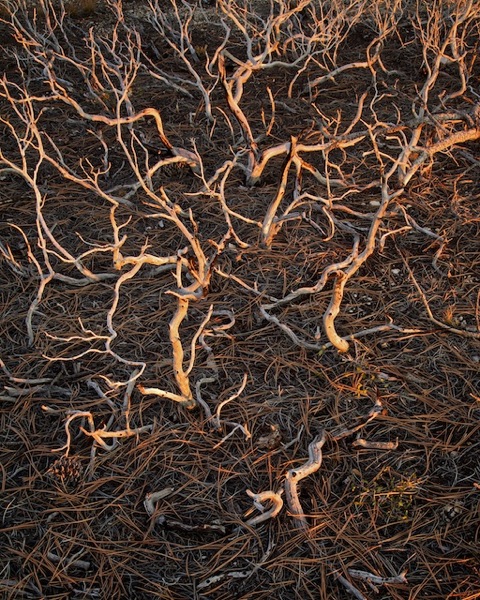Featured photographer

Tim Parkin
Amateur Photographer who plays with big cameras and film when in between digital photographs.

Pete Hyde
A widely travelled landscape photographer with a passion for composition.
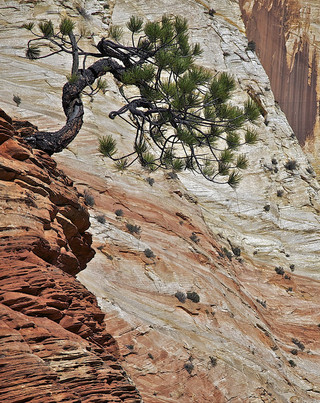 Were talking to Peter Hyde this issue, a great photographer from Lancashire who has been recommended by a few people as someone we need to talk to. We hope you enjoy the read and Peter's pictures.
Were talking to Peter Hyde this issue, a great photographer from Lancashire who has been recommended by a few people as someone we need to talk to. We hope you enjoy the read and Peter's pictures.
In most photographers lives there are 'epiphanic moments where things become clear, or new directions are formed. What were your two main moments and how did they change your photography?
Perhaps the first such moment occurred in late 2004, whilst on a holiday in Florida. We were in a small Everglades’ village where there was a cafe cum craftshop and so we wandered in for a brew. Whilst in there I noticed a row of books on a shelf and picked one up to browse. It was a book of photographs of the Everglades by Clyde Butcher. Looking at his superb black and white images was the first time I had really recognized that landscape photographs could be such a powerfully beautiful art form and, although it took some time to gestate, I believe this was the real starting point of what I now find a near obsession.
The second moment came some years later (March 2009) when I had actually bought a DSLR and taken a place on a L & L photography tour in the Lake District. On the first morning I was crouched on the shore of Ullswater trying to make something of the scene before me. Standing next to me was Clive Minnitt. As I struggled Clive turned to me and quietly said “Have you seen this?” (or words to that effect) and passed me his small compact camera with a shot displayed on the LCD screen. This image was part of the scene I was looking at, but I had not seen it the way that Clive had. His image stripped down the scene to far fewer elements than I had been trying to include, ... my first demonstration of ‘less is more’. Under his guidance I recomposed my shot and a print hangs in my hallway.
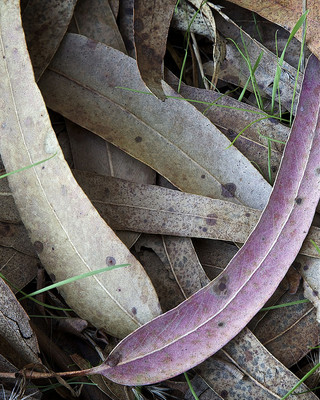 You’ve made some magnificent pictures of the American South West, tell me a about this journey and how it affected your photography.
You’ve made some magnificent pictures of the American South West, tell me a about this journey and how it affected your photography.
Thanks for the compliment Tim, I certainly enjoyed making those images. The first two weeks were on an organised photo-tour, [Canyons in Fall with Nigel Turner] the itinerary of which included many ‘iconic’ locations, including Zion Canyon, Bryce Canyon, Antelope Canyon, Monument Valley and Canyon de Chelly. Afterwards I spent some time exploring the area around and south of the Monterey Peninsula.
I think, as with all the photo-tours I have attended, it did benefit my photography. Simply having so much time to spend immersed in new and interesting locations, with no other ‘focus’ than taking photographs provides lots of practice in looking for subjects and compositions. Utah and Arizona have such amazing geological features that vistas scream out to be taken, but one thing I also recognized was how much I enjoy looking for ‘alternative’ views or more restricted landscapes, and I certainly made more images of bits of rock, dead wood, and patches of forest floor than I had anticipated.
Whilst in the States I was also fortunate enough to visit several galleries and exhibitions. In particular I visited Michael Fatali’s gallery at Springdale and an exhibition of Charles Cramer’s photographs in Carmel and I would challenge anyone not to be inspired by viewing such work close up.
You have a very bold compositional style, using graphic shapes and flow in your images - how did you learn to compose this way?
I find this very difficult to answer but would say, in general, I go with my instincts as to what ‘feels right’ and gives what I hope is an aesthetically pleasing image.
I do look at a lot of photographers work, both in books and on-line, as well as visiting galleries when possible, and this must influence how I want to present images. One style I do adopt at times may result from my working life as a mycologist and plant scientist. I particularly enjoy images that place some intricate detail, such as a plant or lichen, within its wider environment. In order to do this I frequently use a wide angle lens held close to the foreground, and I often choose a vertical format to include the more distant landscape. I sometimes feel such compositions are reminiscent of rather old fashioned field guide illustrations, and maybe this is why I like them.
Nowadays I always compose using ‘live-view’ which I think is helping me to improve this aspect of my photography. I also know that I will often crop an image to a different format and this allows me to tweak a composition on the computer screen. My principle reason for going ‘full frame’ was to let me do this more effectively, ... perhaps I shouldn’t admit to that quite so publicly.
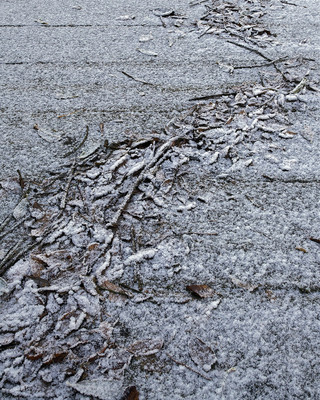 Could you tell us a little about the cameras and lenses you typically take on a trip and how you came to choose it.
Could you tell us a little about the cameras and lenses you typically take on a trip and how you came to choose it.
My main camera is a Canon 5D mark2 and, as I indicated above, one of the reasons for choosing this was it has a lot of pixels to work with, allowing some post-capture cropping without loosing too much resolution. I only have two lenses, the Canon 24-105mm 1:4 L and a 17– 40mm 1:4 L wide angle. I also use a set of Lee soft NDgrads, and I have a 10 stop ND, which is a fairly recent acquisition that I still consider ‘experimental’.
A couple of months ago I bought a compact Panasonic Lumix DMC-LX 5 principally as a “taking on walks camera” but I think it will also get some more ‘serious’ work. As yet have no filters for this.
You take many of your photographs at between f/18 and f/22, something that many 35mm photographers would look in horror at (because of diffraction). Obviously this is done for increased depth of field but will reduce the resolution of your photographs. Did you consciously decide that depth of field was more important than extreme sharpness?
I suspect several of my practices would be looked at “in horror” by more experienced and able photographers Tim, but the small aperture decision is one I often take, especially when using wide angle shots with a low point of view, very close to the selected foreground. I think my approach is somewhat pragmatic in that I mainly want the maximum depth of field and I am not too worried if, as a byproduct, there is sometimes a little softness in the final image. [Possibly I should invest in a tilt and shift lens].
Tell me what your favourite two photographs are and a little bit about them.
I am not too sure about “favorites” but I have chosen two shots from my US trip.
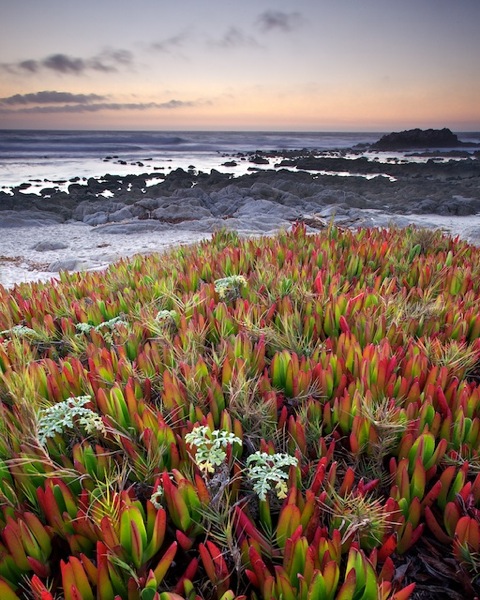
Asilomar State Beach:
This beach is on the Monterey Peninsula, Cal., facing westwards. I like this simple blocked composition with the extended foreground being composed mainly of Hottentot Fig leaves (the main subject), interspersed with a few other leaves of different shapes and colour. The overriding red/green, complementary colour combination provides impact and this was the primary aim here. Beyond the foreground the image is much softer and moving through the layers of rock, sea and sky more muted colouring gives a background which sets the scene but does not compete with the foreground subject matter. The sunsets here are often veiled by sea frets and I think a more colourful horizon and sky would have provided too much distraction from the leaves.
Fire damaged Manzanita:
This shot was taken near the Rim Trail, Bryce Canyon National Park. To my eyes this image is somewhat ‘abstract’. The twisting shapes are produced by bright morning sun striking dead Greenleaf Manzanita stems. The background of pine needles are, as yet, still shaded as a result of the slope of the ground. There are no strong colours, but the contrast between light and dark appeals. I selected a region where there was a gradual gradient in the density of the stems to give some variation as you move from bottom right to top left.
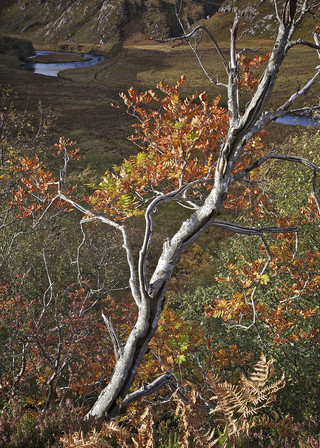 When you are ‘in the field’, what is your usual workflow? i.e. How do you find a picture? Do you take sketch shots and then go back to a choice spot and wait for light? etc.
When you are ‘in the field’, what is your usual workflow? i.e. How do you find a picture? Do you take sketch shots and then go back to a choice spot and wait for light? etc.
Photography is something I do purely for personal pleasure and so I don’t have any specific constraints on what I photograph or how I do it. When out with my camera I look for things that interest me and try to be receptive to all aspects of the landscape from wider views to more restricted subjects. If I see something that I like I try to imagine how it would look as a picture and experiment with view point and framing possibilities, excluding or including different parts of the scene. If things look promising I will then try to make a composition on the camera screen. After making a shot I usually take advantage of ‘using digital’ and check exposure histograms and if necessary adjust the filtration and/or exposure before reshooting, sometimes with the intension of blending exposures. If I think the conditions are changing in an interesting way I may hang around and take another version of the scene. I will sometimes have three or four versions of a similar shot some, or all, of which may end up in the computer’s trash bin.
I don’t take ‘sketch’ shots, but I do sometimes return to certain locations that I have photographed before. I hope that as I become more familiar with a location and see it in different conditions, I will find new possibilities and hopefully exploit them more successfully.
What sorts of things do you think might challenge you in the future or do you have any photographs or styles that you want to investigate? Where do you see your photography going in terms of subject and style?
I am aware that I still lack experience and I need to spend time practicing to improve all aspects of my photography.
I have yet to set myself any specific project but this is an ambition I have, with the intention of creating a collection of images exploring a particular subject or location. One notion that I am considering would be based around the theme of grasses, a family of plants that I have had a long term interest in, but which I now want to explore purely from an aesthetic point of view.
With regard to subject and style I recognise that I really enjoy looking at images of ‘small scale’ landscapes and I would like to develop some skills in this direction.
Who do you think we should feature as our next photographer?
Difficult, ... there are lots of people whose work I admire, but I would be very interested to see a ‘feature’ with Julian Barkway or David Langan

